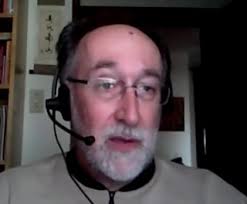Covid-19 : Les masques et les « gestes barrières » sont inutiles (Prof. Denis Rancourt)

Un autre point de vue :
Is it useful to use a face-shield in addition to a mask?
Possibly Yes. After a cough, ~0.85% of the produced particles are inhaled by someone located at 50 cm wearing no mask [1]. Immediately after a cough at 50 cm, it stops 96% of the viral charge and reduces the virus on a mask by 76-97%, which drastically eases the mask decontamination for reuse [1]. The face-shield can also potentially decrease the contamination by the eyes, which can be used very well by that virus [2][3], and avoid touching the face by mistake. However, it does not replace a mask because only 30% of the airborne particles are stopped [1].
[1] Lindsley et al., 2014 [2] Hui et al., 2020 [3] Zhou et al., 2020
Do surgical/medical masks efficiently protect the wearer against the virus?
Possibly yes. The masks were able to filtrate 55 to 88% of 0.1-μm-particles (Rengasamy et al., 2017) using the FDA-approved conservative NIOSH-NaCl method, and to filter 90% of a virus (the Bacteriophage MS2, which is 4 times smaller than the covid-19) in a device with no leak (Davies et al., 2013). Another study found a 0%-filtration efficiency for 2.5-4μm-diameter aerosols containing the H1N1 virus (Quan et al., 2017) but they used only the middle layer of the three mask layers. An observational study of elementary school children in Japan found that children wearing masks decrease by 16% the risk of catching seasonal influenza (Uchida et al., 2017). A randomized study found that people were 70% less likely to catch a respiratory infection when they were wearing a mask (MacIntyre et al., 2009). In addition, they can be useful to avoid spreading the virus (see below). What is true for H1N1 or NaCl is likely for Covid-19. Whether they can replace a N95 respirator is possible but unclear, and it cannot if you are a healthcare worker: in two meta-analyses, healthcare workers were as ill when using a N95-respirator as when using a surgical mask (Bartoszko et al., 2020, Long et al., 2020). Another review contradicted the meta-analysis but had clear conflict of interests (MacIntyre & Chughtai, 2015).
Further reading:
Important database of scientific reviews: https://www.n95decon.org/
Reviews of surgical masks not working for healthcare workers: https://www.researchgate.net/publication/340570735_Masks_Don’t_Work_A_review_of_science_relevant_to_COVID-19_social_policy
But see: https://www.phc.ox.ac.uk/publications/1102534, https://www.journalofinfection.com/article/S0163-4453(20)30235-8/pdf and https://rs-delve.github.io/reports/2020/05/04/face-masks-for-the-general-public.html
An experiment showing that people are failing to wear their mask correctly to be efficient: https://www.sciencedirect.com/science/article/pii/S0196655307007742
A recent meta-analysis: https://www.thelancet.com/action/showPdf?pii=S0140-6736%2820%2931142-9
Does wearing surgical/medical masks limit the spread of the virus?
Likely Yes. Surgical masks can reduce detectable viral shedding in respiratory droplets and aerosols of symptomatic individuals with coronavirus (Leung et al., 2020) and are useful to avoid dissemination from the wearer, decreasing by 6 the number of cough-produced particles and microorganisms (Davies et al., 2013).
Further reading: https://www.ncbi.nlm.nih.gov/pmc/articles/PMC3591312/
A recent meta-analysis: https://www.thelancet.com/action/showPdf?pii=S0140-6736%2820%2931142-9
Can we reuse surgical masks?
Possibly yes. The recommended duration of a surgical mask varies by countries. In Hong Kong and China, no more than 4 hours is recommended before disposal by experts (Ho, MingPao, 7 January 2020; Chung, HK01, 7 February 2020). In Taiwan it references the guidance in the US, and recommends a duration of no more than 8 hours cumulatively (National Taiwan University Public Health College, SARS Promotion Material, Principles for using Masks). After that duration, masks should be discarded. However, recent studies indicated that ‘dry-steaming’ may allow these masks to be reused one to five times (see Sterilization section). Leaving the mask in a bag for a few days is not an acceptable method for sterilization because the virus can survive more than 7 days on the mask (Chin et al., 2020). Bleach will certainly leave smell and possibly toxic waste (Viscusi et al., 2009). UV sterilization might be inefficient because UV light cannot reach the middle (filter) mask layer. Salt or copper coating has been proposed but without evidence that multiple cycles does not degrade mask filtration or resistance (Quan et al., 2017).
Do N95/FFP2 respirators efficiently protect against the virus?
Certainly Yes. (adapted from Bar-On et al., 2020). N95 / FFP2 masks are designed to filter 95% of the 0.3-μm particles. In fact, measurements of the N95 efficiency show that they are filtering ≈99.8% of 0.1-μm-particles (Rengasamy et al., 2017). Therefore, N95 masks are capable of filtering most free virions (diameter ~0.1 μm), but also droplets produced by sneezing and droplet nuclei (aerosols). N95 masks are comparable to other international mask norms (see glossary) and this should indeed be true for them too. Note that respirators with a valve should be avoided if you are infected because the virus can spread through the valve when coughing.A recent meta-analysis: https://www.thelancet.com/action/showPdf?pii=S0140-6736%2820%2931142-9

